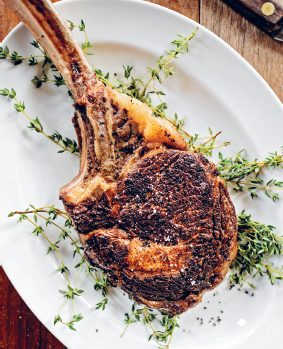SEARING

Do Small Things Well
Even the most complex recipes are the sum of many simple acts like searing. Putting those small acts together makes a great cook.
Searing gives complexity of flavor and adds texture by creating a crust. However, it doesn’t seal in juices or keep ingredients moist, as kitchen lore suggests.
If you use a heavy pan with the right amount and type of oil and the right heat, the pan will get hot enough, retain heat well, and not smoke up the place. Making sure the food is free of moisture from water or water-based marinades is important. The moisture causes steam which slows the searing process and drops the temperature. Ingredients that are dry or very lightly and evenly coated in oil sear better.
Searing begins at around 300°F for dry ingredients. Extra-virgin olive oil has a smoke point of approximately 375°F. So, you can sear food with olive oil, but if the heat level exceeds its smoking point, you’ll have a smoky kitchen and acrid-tasting food. The higher the smoke point of the oil, the lower the chances of causing havoc with fire alarms, nervous pets, a smelly house, and teary eyes. Admittedly, it’s hard to control the temperature of a pan on a stovetop. A skilled cook is constantly adjusting the heat to get it just right.
At home, I like to oven-sear for more accuracy and less smoke. If your oven is set to 375°F, the pan won’t get hotter than that. Also, the oven keeps a food’s aroma contained to a certain extent (so your whole house doesn’t smell like fish for days after cooking it). To properly sear in the oven, I wait until the oven is fully preheated, then I heat the pan I’ll be cooking with. I use a heavy cast-iron flat skillet or an enamel-coated cast-iron double-burner skinny skillet. A grill pan works well too, if you’re after the look of grill marks.
Tossing your ingredients in a bowl with a small amount of oil and seasoning ensures that everything is evenly coated and that you’re not using too much oil. The food should sizzle a little when it hits the preheated pan. Of course, be careful pulling the preheated pan out of the oven to add the ingredients, as it will be very hot. For even searing, stir cut foods every 5 to 10 minutes and occasionally flip large portions.
Whether cooking on the stovetop or in the oven, avoid searing with too much cooking oil. It can splatter and make a mess of your oven, not to mention smoke a lot. There’s also the slim chance of hot oil splattering and hitting the heating element or flame and igniting. If the food is free of excess moisture and the temperature is right, this won’t happen.
I cringe when I see cooks unwrap fish or meat from plastic-wrapped packages and put it directly into a hot pan. The moisture on food that has lived in a plastic package for days creates steam when cooked, which interferes with browning and toughens up the protein, compromising taste. That’s why fishmongers and butchers wrap food in waxed or butcher paper. Unlike plastic, these wrappers keep meat and fish free from excess moisture. Dry meat sears better, absorbs flavor more efficiently, and tastes fresher.
When I get back from the market, I remove ingredients from their packaging and store them in a way that helps them retain their freshness. Dry off meat and fish with a paper towel and wrap them in butcher or parchment paper, then place them in a glass dish sealed with a lid. If freezing food, dry it, marinate it in an aromatic marinade, and freeze in an airtight glass container labeled with the date and contents. The freezing and storing process enhances the effect of the marinade, and in turn, the marinade coats the food, preventing freezer burn and that weird freezer taste.
Here’s another key to proper searing, which is true for blanching as well: Don’t overcrowd the pan or pot. Placing too much food in at one time causes a quick drop in temperature. Instead of the high-heat, rapid cooking you want for searing, the food in the pan will steam. When blanched in an overcrowded pot of boiling water, green vegetables lose their color and vibrancy. Cook in batches, if necessary. If you’re cooking a big meal, you might need to strategize oven and stovetop space. It might take more time, but it will be worth it in terms of the flavor, color, and texture of your dish. 
